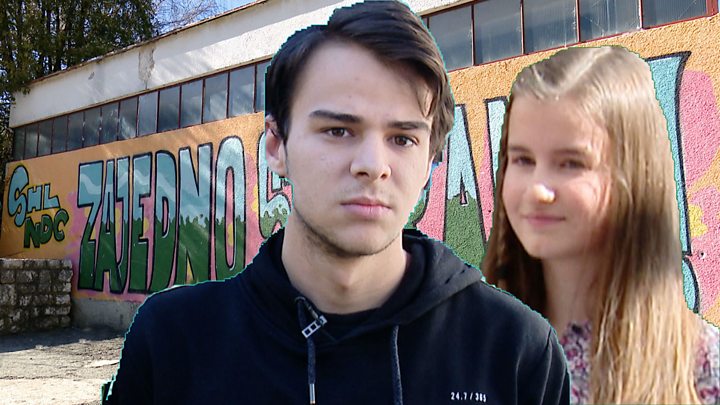The children challenging segregation in Bosnia’s schools
“I am separated from my good friend, Amra; we can only spend time together at weekends,” 11-year-old Asja Besirevic complains.
You would think her friend had moved to the other side of country.
In fact, Amra is in the same school building in the small, central Bosnian city of Jajce. Just not the same school.
This is a prime example of the widespread policy known as “two schools under one roof”, which splits students based on their ethnicity.
Here in Jajce, Bosniak Muslim students like Asja enter through the door marked “Berta Kucera Primary School”.
There is a separate entrance for ethnic Croat pupils attending the 13 September School.
It is not quite a case of never the twain shall meet. The children may cross paths in the atrium, which contains bulletin boards for both schools and serves as an assembly and performance venue for the Berta Kucera students.
Adults intersect as well. A Catholic nun passes a Muslim woman in a headscarf as she makes her way into the 13 September section of the building.
This gives a brief impression of multiculturalism, but that is not how it feels to Asja.
“I would like us all to be together and mixed. To me, it’s wrong they’re dividing us and I’m really sad about it.”
Why Bosnia’s schools were divided
Jajce and much of the surrounding area became a battleground in the 1990s, during the conflict between Croat and Bosniak forces.
Schools were sucked into the struggle as ethnic leaders attempted to impose their ideologies in the classroom.
The Dayton Peace Agreement brought an end to the fighting in 1995, but it baked in the ethnic divisions.
It split Bosnia into the mainly ethnic-Serb Republika Srpska and the Federation, which is mostly shared by Croats and Bosniaks.
The Federation embarked on the “two schools” policy ostensibly to encourage displaced families to return home.
The concept offered reassurance that children would not face indoctrination or discrimination at the hands of people who had recently been the enemy. More than 50 schools were split in this way.
But it soon became clear that the system risked reinforcing divisions.
Western diplomats put pressure on the Federation to merge schools but authorities refused. “You can’t mix apples and pears,” offered one senior education official in justification.
Indeed, rather than educate children together, there have even been efforts to increase the segregation, although this has met fierce resistance from the students themselves.
More stories from Bosnia
How students challenged segregation
Up the hill from Berta Kucera and 13 September, the vocational high school remains mixed, following a student-led campaign to prevent segregation.
“You’re brought up being taught that others are no good and you don’t spend a single hour learning about their culture, beliefs or values,” says Ivica Jukanovic, who was one of the leaders of the campaign.
“Often, students are taught to hate by their parents in their homes, because the parents went through the war. If they’re taught to hate others at home and then go to segregated schools, they will know nothing but hate.”
Back at the primary schools, children tear around their separate playgrounds, seemingly unconcerned. But their head teachers hold strikingly different views on how they should be educated in the future.
“The system as we have it now is a cancer, if you ask me,” says Berta Kucera’s director, Fikret Cancar.
“I’m waiting for the day when the whole system will be reconstructed and united. I don’t see this in the near future – but I say to everyone who comes here: I’m waiting for the day.”
But his Croat counterpart at 13 September, Iva Ladan, is far less enthusiastic about the prospect of a merger.
“There is room for improvement, but the decision has to be made at a high level,” she says.
The chances of such a high-level decision seem slim.
Bosnia’s ethnic political leaders have operated on a divide-and-rule basis for more than two decades. That gives them every reason to perpetuate the “two-schools” policy.
Source: Read Full Article




